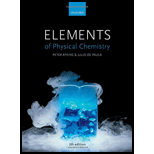
Concept explainers
(a)
Interpretation:
An open vessel contains water in a laboratory measuring
Concept introduction:
The number of moles of any substance can be determined using the equation
The molar mass of an element or compound is the mass in grams of 1 mole of that substance, and it is expressed in the unit of grams per mole (g/mol).
Ideal gas equation,
(a)
Explanation of Solution
Given,
An open vessel contains water in a laboratory measuring
Volume of vessel can be determined as follows,
Moles of water in this volume under the given consitions can be determined using Ideal gas equation as follows,
The mass of water can be determined by multiplying this amount of water with its molar mass.
Thus,
(b)
Interpretation:
An open vessel contains benzene in a laboratory measuring
Concept introduction:
The number of moles of any substance can be determined using the equation
The molar mass of an element or compound is the mass in grams of 1 mole of that substance, and it is expressed in the unit of grams per mole (g/mol).
Ideal gas equation,
(b)
Explanation of Solution
Given,
An open vessel contains benzene in a laboratory measuring
Volume of vessel can be determined as follows,
Moles of benzene in this volume under the given consitions can be determined using Ideal gas equation as follows,
The mass of benzene can be determined by multiplying this amount of benzene with its molar mass.
Thus,
(c)
Interpretation:
An open vessel contains mercury in a laboratory measuring
Concept introduction:
The number of moles of any substance can be determined using the equation
The molar mass of an element or compound is the mass in grams of 1 mole of that substance, and it is expressed in the unit of grams per mole (g/mol).
Ideal gas equation,
(c)
Explanation of Solution
Given,
An open vessel contains mercury in a laboratory measuring
Volume of vessel can be determined as follows,
Moles of water in this volume under the given consitions can be determined using Ideal gas equation as follows,
The mass of mercury can be determined by multiplying this amount of mercury with its molar mass.
Thus,
Want to see more full solutions like this?
Chapter 4 Solutions
Elements Of Physical Chemistry
- Calculate the pH and the pOH of each of the following solutions at 25 °C for which the substances ionize completely: (a) 0.000259 M HClO4arrow_forwardWhat is the pH of a 1.0 L buffer made with 0.300 mol of HF (Ka = 6.8 × 10⁻⁴) and 0.200 mol of NaF to which 0.160 mol of NaOH were added?arrow_forwardDetermine if the following salt is neutral, acidic or basic. If acidic or basic, write the appropriate equilibrium equation for the acid or base that exists when the salt is dissolved in aqueous solution. If neutral, simply write only NR. Be sure to include the proper phases for all species within the reaction. NaN₃arrow_forward
- A. Draw the structure of each of the following alcohols. Then draw and name the product you would expect to produce by the oxidation of each. a. 4-Methyl-2-heptanol b. 3,4-Dimethyl-1-pentanol c. 4-Ethyl-2-heptanol d. 5,7-Dichloro-3-heptanolarrow_forwardWhat is the pH of a 1.0 L buffer made with 0.300 mol of HF (Ka = 6.8 × 10⁻⁴) and 0.200 mol of NaF to which 0.160 mol of NaOH were added?arrow_forwardCan I please get help with this.arrow_forward
- Determine if the following salt is neutral, acidic or basic. If acidic or basic, write the appropriate equilibrium equation for the acid or base that exists when the salt is dissolved in aqueous solution. If neutral, simply write only NR. Be sure to include the proper phases for all species within the reaction. N₂H₅ClO₄arrow_forwardPlease help me with identifying these.arrow_forwardCan I please get help with this?arrow_forward
 ChemistryChemistryISBN:9781305957404Author:Steven S. Zumdahl, Susan A. Zumdahl, Donald J. DeCostePublisher:Cengage Learning
ChemistryChemistryISBN:9781305957404Author:Steven S. Zumdahl, Susan A. Zumdahl, Donald J. DeCostePublisher:Cengage Learning ChemistryChemistryISBN:9781259911156Author:Raymond Chang Dr., Jason Overby ProfessorPublisher:McGraw-Hill Education
ChemistryChemistryISBN:9781259911156Author:Raymond Chang Dr., Jason Overby ProfessorPublisher:McGraw-Hill Education Principles of Instrumental AnalysisChemistryISBN:9781305577213Author:Douglas A. Skoog, F. James Holler, Stanley R. CrouchPublisher:Cengage Learning
Principles of Instrumental AnalysisChemistryISBN:9781305577213Author:Douglas A. Skoog, F. James Holler, Stanley R. CrouchPublisher:Cengage Learning Organic ChemistryChemistryISBN:9780078021558Author:Janice Gorzynski Smith Dr.Publisher:McGraw-Hill Education
Organic ChemistryChemistryISBN:9780078021558Author:Janice Gorzynski Smith Dr.Publisher:McGraw-Hill Education Chemistry: Principles and ReactionsChemistryISBN:9781305079373Author:William L. Masterton, Cecile N. HurleyPublisher:Cengage Learning
Chemistry: Principles and ReactionsChemistryISBN:9781305079373Author:William L. Masterton, Cecile N. HurleyPublisher:Cengage Learning Elementary Principles of Chemical Processes, Bind...ChemistryISBN:9781118431221Author:Richard M. Felder, Ronald W. Rousseau, Lisa G. BullardPublisher:WILEY
Elementary Principles of Chemical Processes, Bind...ChemistryISBN:9781118431221Author:Richard M. Felder, Ronald W. Rousseau, Lisa G. BullardPublisher:WILEY





